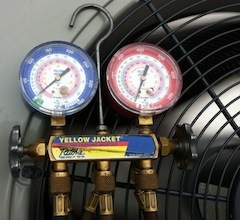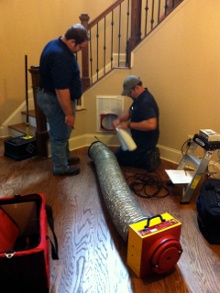Why Don’t More HVAC Contractors Own Duct Leakage Testers?

 HVAC contractors own a lot of equipment. Of course, they have the pressure gauges to test refrigerant charge in air conditioners and heat pumps and many more pieces of technical equipment. One piece that few contractors own, however, is a duct leakage tester. With more and more state energy codes requiring duct leakage tests, doesn’t it seem obvious that HVAC contractors need to be like plumbers and test their own work before passing it off?
HVAC contractors own a lot of equipment. Of course, they have the pressure gauges to test refrigerant charge in air conditioners and heat pumps and many more pieces of technical equipment. One piece that few contractors own, however, is a duct leakage tester. With more and more state energy codes requiring duct leakage tests, doesn’t it seem obvious that HVAC contractors need to be like plumbers and test their own work before passing it off?
HVAC contractors own a lot of equipment. Of course, they have the pressure gauges to test refrigerant charge in air conditioners and heat pumps and many more pieces of technical equipment. One piece that few contractors own, however, is a duct leakage tester. With more and more state energy codes requiring duct leakage tests, doesn’t it seem obvious that HVAC contractors need to be like plumbers and test their own work before passing it off?
Here’s another compelling reason for contractors to own duct testers: The ENERGY STAR new homes program now requires the duct leakage test to be done at the final inspection, not rough-in. With Revision 06, Footnote 17 in the HVAC System Quality Installation Rater Checklist says:
Duct leakage shall be determined and documented by a Rater using a RESNET-approved testing protocol only after all components of the system have been installed including the air handler, the ductwork, the duct boots, and the register grilles atop the finished surface (e.g., drywall, carpeting, flooring).
And just in case that isn’t clear enough, they wrote this in the Revision 06 Highlights:
To clarify, duct leakage testing must occur when the duct system is in its final state, which is to say after all components of the system have been installed including the air handler, the ductwork, the duct boots, and the register grilles atop the finished surface (e.g., drywall, carpeting, flooring). A leakage test at “rough-in” does not meet this intent, though may be helpful for identifying leaks that need sealing. [Emphasis added.]
I think this is a great change in the program because I’ve always had a problem with using a rough-in duct leakage test as the final result, which many HERS raters have done. Testing at rough-in is a great idea because you can catch problems before they become much more difficult and expensive to fix. Once the drywall goes up, access becomes a big issue. But as ENERGY STAR now realizes, a rough-in test is not good enough to use in a home energy rating.
problems before they become much more difficult and expensive to fix. Once the drywall goes up, access becomes a big issue. But as ENERGY STAR now realizes, a rough-in test is not good enough to use in a home energy rating.
Back to the original question now, why don’t more HVAC contractors own duct leakage testers? If they’re installing ducts, they really should ensure that the ducts have been intalled and sealed properly. If a third party’s going to come in when the house is complete and test for duct leakage, it only makes sense for the contractor to test at rough-in so they know they’ll pass at final.
I realize that there’s a lot of pressure on HVAC contractors working in new construction to keep their prices rockbottom. Now, with building codes raising the standards, they’re being pulled in the other direction, too. It’s almost like homebuilders and code officials are doing an experiment to determine the tensile strength of HVAC contractors.
I’m not an HVAC contractor, but if I were, I’d definitely own a duct leakage tester. They’re not really that expensive, as the prices have come down significantly in recent months. TruTech Tools is selling them for a little over a thousand dollars. Just 3 years ago, I bought one for nearly two grand.
Some people call me a purist because of my stands on issues like this. I guess I am, in a way. I also believe in following Steve Martin’s advice:

In this changing environment for HVAC and homebuilding, you’ve got to be good.
Related Articles
Why Won’t the HVAC Industry Do Things Right?
ENERGY STAR Version 3 Is Live! Where Are the HVAC Contractors?
Testing for Duct Leakage in a House with an Encapsulated Crawl Space
This Post Has 23 Comments
Comments are closed.

Great article Allison. Some
Great article Allison. Some counties here in NC are now requiring duct leakage to be checked before they will pass the mechanical inspection. Only makes sense these guys should test their work before sheetrock is installed. I recently did a rough in inspection that failed and the leaks were behind the sheetrock. Now they can’t pass mechanical inspection without ripping out sheetrock. One or two problems like this would more than pay for the duct blaster!
A better solution is to have
A better solution is to have 2 sets of duct leakage standards. One for ducts in conditioned space, one for ducts in unconditioned space. Contractors might actually start moving ducts into conditioned space in order to make complying with the leakage test easier.
IMHO getting ductwork and air handlers out of attics will save more money to the homeowner than leakage testing.
It is my experience locally
It is my experience locally in Texas, that HVAC contractors are not very comfortable working with numbers. They will measure with their gauges when necessary, but following detailed procedures is contrary to their instincts. Witness the oft-told claim that Manual J can be made to say anything they want to… no pangs of conscience about plugging in truly false info in the first place. Witness how many techs seldom or never measure static pressure… they assume a number and base their work on that assumption.
Having to work in hot summer attics does not help broaden the talent base. It is a rough job and not that many people want to work for what it pays. IMO it *should* evolve toward a consulting position and pay better.
Bob, There are two standards
Bob, There are two standards for Energy Star and thus two tests. Duct Leakage Total – Can be done at Roughout. Duct Leakage to the Outside, must be done with the Blower Door Running.
Allison, Thanks for the pointers on this one. I’ve been testing at rough out (AH installed). Total leakage < the Leakage to the Outside Limit is the norm. With R6 – I will start doing leakage to the outside with the Blower Door at such time as it meets the R6 Requirements.
The last two sentences of FN 18: “Alternatively, testing of duct leakage to the outside can be waived if total duct leakage is ≤ 4 CFM25 per 100 sq. ft. of conditioned floor area, or ≤ 5 CFM25 per 100 sq. ft. of conditioned floor area for homes that have less than 1,200 sq. ft. of conditioned floor area.”
Can you comment?
The 2009 IECC energy code
The 2009 IECC energy code (requiring duct testing) is to become South Carolina law starting Jan 1 2013. I am touring the state with the training organization updating code inspectors and builders, demonstrating use of the duct blaster, assuring builders that the test is easy, quick and cheap, and pushing code inspectors to require 3rd party testing.
John, I’m not following you
John, I’m not following you on total leakage being done at rough-in. The difference I find between the leakage to unconditioned spaces and the total leakage is mostly found in the leakage at the air handler cabinet and the leakage between the grilles and the drywall. This can’t be tested at rough-in. Can you give us a reference for the test being allowed at rough-in?
Walter, You can do a duct
Walter, You can do a duct leakage for total any time the ducts are in. Can you use it for Energy Star? Not with R6.
I choose to do a helpful ‘Total’ test at rough in, with the air handler in place to assist my HVAC contractor. If he has to fix something, no sheet rock in the way.
I am fighting an uphill battle to move Builder to ES 3.0. It will take extra effort from me to earn their business.
I will still have to go back and do the tests at required times. It gives everyone a lot of confidence that the systems will test at the proper time, when you get a total duct leakage to come in at 3.8 CFM at 25 per 100 sf.
I’ve never understood how
I’ve never understood how HVAC contractors can tout tight ducts, yet they don’t own a duct blaster. (Sorta like foam insulators who sell tight envelopes but they don’t own a blower door!) You can’t see air leak. So where’s your QA, Mr. Contractor? Even the best crews make mistakes.
One thing the new codes accomplish is leveling the playing field a bit. HVAC contractors who do it right aren’t at as much of a disadvantage cost-wise.
@John N: I wonder why ESv3
@John N: I wonder why ESv3 has the “performance path” exception for R6 ducts in attics. The IECC has required R8 in attics since 2006 I believe. Although not all areas enforce the IECC, prices for R8 have dropped as a result. In any case, I would never specify R6 for attic ducts regardless of how tight they are.
I worry about how this V3
I worry about how this V3 change affects cost to the builder. While it makes total sense to me to test after the home is complete for accuracy, I worry about builders and HVAC teams skipping the rough in test to save on the cost of testing the system twice. If* a system fails at final when ducts are buried behind rock it could be a much bigger problem.
David B, I would suggest
David B, I would suggest that Performance Path allows the ducts to be lower as a Trade off for something else. Say R-49 attic instead of R-38. Or R-15 slab edge instead of R-10.
Ryan, I am sure that some builders will try to save the price of the rough in test and get burned. As a rater it is my job to educate the builder and HVAC contractor to avoid that.
John: Agreed, but I still see
John: Agreed, but I still see this as a cost issue. With this new requirement the cost of duct testing for ENERGY STAR just doubled. That said, in the Northwest ENERGY STAR program ducts inside conditioned space do not need to be tested. Therefore this is all the more reason to build with ducts inside or not use ducts at all!
@John: you’re talking about a
@John: you’re talking about a total building performance path, which is supported by the IECC. However, with ESv3, the trade off is specifically tied to duct leakage. When ducts are in the attic, they need to be tight and well insulated, not one or the other. Bottom line, I disagree with this v3 option.
Thanks for all the great
Thanks for all the great discussion in the comments! I’ve just returned from a short backpacking trip and will respond sometime this weekend. I have to get back to Atlanta now.
Allison – I think you
Allison – I think you answered your own question: “shall be determined and documented by a Rater”. Even if the HVAC techs use a Duct Blaster for QA work, the final tests need to be done by a rater so (from the builder’s point of view) there is no financial incentive to the investment since they are going to pay for the rater regardless; for the HVAC subs – it is less expensive to re-do or patch leaks than get the equipment and adequate training. And once they get “the hang of it”, HVAC techs can usually pass the duct tests w/o any additional work.
Allison – You really need to
Allison – You really need to differentiate between new construction and retrofit contractors to understand the issue. While there are exceptions, most home builders are concerned with getting the lowest cost possible from ALL of their sub-contractors, including HVAC. As a sub-contractor, they work for the builder as their customer, not the end user, and deliver them the product that they want.
This is a race to the bottom that has resulted in corner-cutting, poor design and build quality, and ultimately, poor results for the homeowner. Like many other quality HVAC contractors we simply chose not to do new construction as a result.
We work directly for the homeowner, and are there to help them solve problems in their home. We own 5 duct leakage testers, just as many balometers, and a blower door, and we use them every day to identify problems in existing duct-work. We make repair recommendations, based on testing results, to correct problems with comfort, energy efficiency and indoor air quality. Oftentimes, the problems we fix have existed since the home was built, and the homeowner just accepted them.
In the end, changes in building code (like our Energy Code in Washington state)will force builders to pay for the duct work that homeowners should have had all along, and better HVAC contractors will be happy to provide it (and test it). The customer will ultimately have to pay the price for this, but they’ve been paying it all along in energy loss and poor comfort without knowing it.
This change will not come by itself though. Either changes to building codes or consumer demand will need to force most builders down this path for it to really happen.
most hvac companies say their
most hvac companies say their ducts don’t leak….
that is what I’ve heard over and over…when my duct testing shows a minimun of 30% leakage.
but then I’m an energy rater & don’t work for hvac company….just my pov/experiences in the field
While reading this article at
While reading this article at close to two am with a kitten asleep to my left in the inbox. At least one of us has sence! I can’t help but thinking of “Pet Doors” installed on houses and what that does to the overall building envelope? Does anyone have any good updated info on this one? Or is there such a thing as a E-star rated pet door? Yes I know how silly that question sounds. But what to you do with a home owner that loves their animals! This probably best falls under attention to detail for buildinjg contractors. All that work and then someone installs something like this, and can be even worse on more than one door to the outside. Just a thought!
Allison, some local town
Allison, some local town codes in NY require a 3rd party to test for duct leakage so we cant test our own systems for code purposes, although it is a good idea to test your own ductwork before you have the 3rd party check just to avoid the embarassment later.
I agree with testing at rough
I agree with testing at rough-in, just to let the installers know where they have to put extra emphasis. I do this for custom builders just to let them know where they stand. Usually two such tests show them where their weaknesses lie. Under ENERGY STAR, however, what is the importance of the total duct leakage when the Qn is less than .02? Leakage to conditioned space is not as important when we know that the ducts are tight. Why does ES put such emphasis on this leakage? I’m missing something, I guess.
Kenneth, A builder I work
Kenneth, A builder I work with in Salem Oregon had to find a pet door suitable for their Passive House project. They exist! Check it out: http://www.energyefficientdogdoors.com/door-for-dogs-passive-house-design
I need standart which allow
I need standart which allow lighting test to find out the leakage point in the hvac ducts.
I posted the link to the hvac
I posted the link to the hvac forum I’ve been a member of since 2004.
suprising the amount of just don’t want to do the testing. lots of reasons why..how to sell the job, my ducts don’t leak..expensive equipment..time to learn something..lack of capacity to learn.
I was even told by an ‘energy auditor’ in NJ
that not only is it not necessary to test leakage..that it isn’t necessary.
now I live in the south..no basements, but to date no one has been able to explain to my energy rater mind how not mastic sealing & insulating ducts is a good install.
I think it is just…sad.